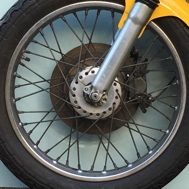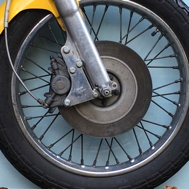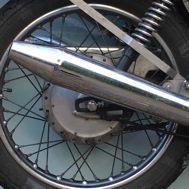Recently I called on a former work colleague and fellow biker to show him my Fastback. Virtually his first comment was to remark that the front wheel spokes appeared to be thicker than the rear wheel ones.
I’d never considered the point, but on looking this indeed appeared to be the case, so I set out to compare what is fitted to what is specified in the Workshop Manual.
Workshop Manual
Front wheel
Spokes - Disc brake wheel: Inner L.H. - 90° head 9 SWG 0·270 in. (6.9 mm) head
Outer L.H. - 90° head 9 SWG 0·270 in. (6.9 mm) head (80º bend)
Right hand - 90° head 8 SWG 0·290 in. (7.35 mm) head
Rear wheel
Spokes: Rear outer: 6·093 in. long: 8/10 SWG : 90º head: offset length 0·531 in. (13'45 mm)
Rear inner: 6·093 in. long: 8/10 SWG : 90º head: offset length 0·375 in. (9.5 mm)
So the front wheel spokes are indeed intended to be heavier gauge than the rear.
Q(1): Would it be right to assume that this is because—on an optimistic view of the brake’s potential—the front wheel might have to bear the entire weight of the machine plus rider (and perhaps plus pillion and luggage)?
Q(2): Likewise, is the differential between LH and RH due to the idiosyncratic relationship of the rim to the hub flanges?
My bike
Front wheel
Both sides, inner: 8 SWG, outer: 9 SWG.
Rear wheel
As workshop manual, save that both inner and outer spokes have the longer offset.
Q(3): For obvious reasons this is not an area where one wants to take liberties with the spec. Can anyone suggest any concerns with the non-standard front wheel spoking?
Q(4): Can anyone suggest what reasoning might have motivated this choice?
Finally, I also checked the spoking on the PR front wheel that I am refurbishing. It is 8/10 SWG as for the rear wheel.
Q(6): Can anyone confirm that this is correct?



Spokes usually fail…
- Log in to post comments
The workshop manual is a…
The workshop manual is a single shapshot, they changed the spoke gauges and the nipple sizes over the life of the pre MK3 850. My MK2a has the bigger nipples on the rear rim as an example.
- Log in to post comments
David's remarks are…
David's remarks are reassuring. Since having to look into this I realise how little the technology of wire wheels is discussed in motor cycle literature and forums.
It seems intuitive, to this layperson, that the bend in a spoke is the site of highest stress and hence of most likely failure. (Is this the reason for butted spokes—to put more metal where the stress is?)
But why do (did) so many manufacturers persist with this feature? It's not difficult to design hubs to use straight spokes—just glance at a humble MZ 250—so I suspect the answer is that traditional hubs are cheaper to make.
- Log in to post comments
The design of wheels and…
The design of wheels and spokes is a large topic in itself. Butted spokes give strength where it is needed but also allow a different size in wheels, piercings etc to be used, as they can be laced without touching the crossing spokes where thicker gauge spokes would touch. This is sometimes seen on stainless wheel builds.
As above the wheel is a 'fluid' item, imagine the forces from all angles, and not just from the tyre, spindle relation to rim etc, then you can see what a wheel has to put up with. Still used on modern adventure bikes for this reason.
The simple spoke, looks like a bit of bent wire, but one of the best bits of engineering on a bike.
- Log in to post comments
I believe the fact that some…
I believe the fact that some use straight and some use hooked ends shows that the design of spoked wheels is very largely "empirical". That is..done in the light of experience and, to some extent, the opinions and prejudices of the designer. So one firm uses one design, and another used a different one.
I think the hook is likely to perform better because it doesn't depend so much on the slight vagaries involved in forging the upset ends. Presumably others will disagree. Changes in design tend to affect their life expectancy, not absolute strength, so it would take years of trials of different designs on identical bikes used i the same way to work out which is best. Probably.
There are all sorts of theories about the best spoke patterns. Some cycling web sites show lots of options. But by and large they all work provided they are symmetrical. The risky one is radial spokes which are fashionable for Custom cycles and motorcycles but they increase hoop stress in the hub. Not safe on a motorcycle unless someone has designed the hub specially.
The load path is interesting (to me anyway). The contact force from the road causes the small number of bottom spoke tensions to fall according to the load. But all the other spokes, around most of the circle, see their tensions rise by a smaller amount. Spoke tension should be high enough for the bottom spokes not to go slack except under extreme loads. But the point is that big impact loads cause big drops in a few tensions but only small increases. Which is why they are so resistant.
- Log in to post comments




Spokes usually fail eventually due to fatigue. That is the accumulation of huge numbers of loading cycles. So the most likely effect of having slightly thinner spokes should be to shorten the life before an individual spoke breaks (at its head), rather than lead to risk of collapse of a wheel.
I can't see any logic in having different inner and outer as yours seems to have. The trailing spokes carry more braking tension but fatigue is due to change in stress (down as well as up) and the leading spoke tensions change the same amount in the opposite direction.
But it is logical to have thicker ones on the disc side where there is less dishing so the spoke tensions are much higher, as the Norton data appears to show.
I would be annoyed but not worried. Other direct experiences of spoke breakages might be interesting?